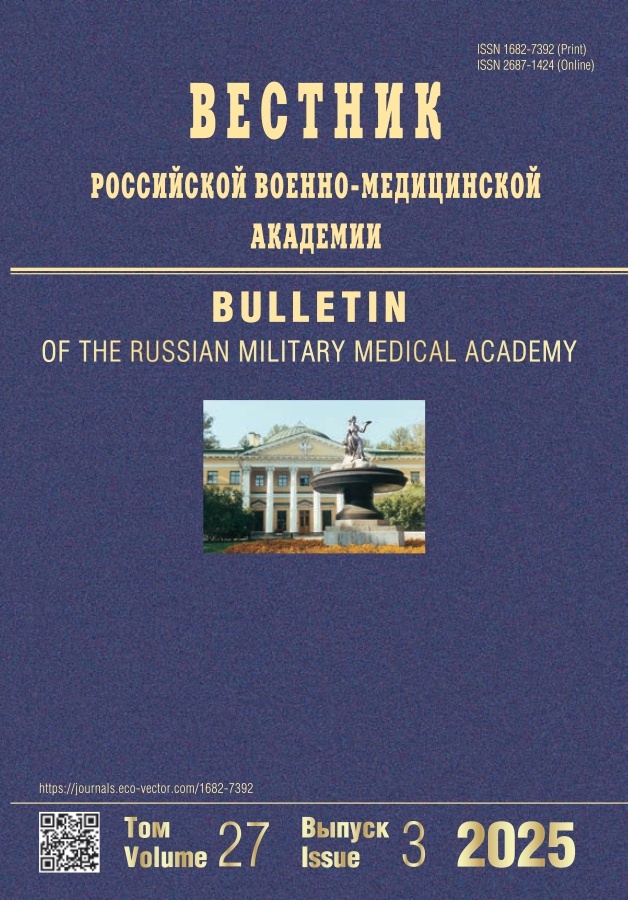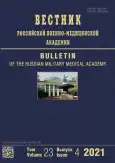Evaluation of vaccine "Sputnik V” immunogenicity and reactogenicity when it is used in military personnel
- Authors: Zhogolev S.D.1, Gorenchuk A.N.1, Kuzin A.A.1, Kulikov P.V.1, Zhogolev K.D.1, Apchel V.Y.1,2, Sergeev T.S.3, Lantsov E.V.1, Artebyakin S.V.1, Zharkov D.A.1
-
Affiliations:
- Military Medical Academy named after S.M. Kirov of the Ministry of Defense of the Russian Federation
- A.I. Herzen Russian State Pedagogical University of the Ministry of Education and Science of the Russian Federation
- 985 Center for State Sanitary and Epidemiological Supervision Ministry of Defense of Russia
- Issue: Vol 23, No 4 (2021)
- Pages: 147-152
- Section: Clinical trials
- URL: https://journals.rcsi.science/1682-7392/article/view/80760
- DOI: https://doi.org/10.17816/brmma80760
- ID: 80760
Cite item
Abstract
The article presents the results of a study of the immunogenicity and reactogenicity of the vaccine Gam-COVID-Vac (Sputnik V) when used in military personnel undergoing military service on conscription. From 300 military personnel consistently vaccinated with one and two components of Gam-COVID-Vac at the intervals of 21 days, blood serum was obtained and examined three times: before vaccination, and 30 and 60 days after the introduction of the first component of the vaccine. In the blood serums, the content of Class G antibodies to the SARS-CoV-2 was determined by the method of solid-phase enzyme immunoassay. After immunization with the Gam-COVID-Vac vaccine, the average geometric titer of Class G antibodies to SARS-CoV-2 -in the blood serum of a military personnel obtained during the second and third examinations (5.02 log2 and 5.67 log2) increased by 2.4 and 2.7 times, respectively (p < 0.05), compared to the same indicator before the vaccination (2.11 log2). Total of 30 days after the introduction of the first component of the vaccine (Nine days after the introduction of the second component of the vaccine), Class G antibodies to the new coronavirus SARS-CoV-2 were detected in the 86.7% of military personnel, and after 60 days — in 92% of vaccinated. Studies have revealed moderate reactogenicity of the vaccine. Moreover, the proportion of postvaccination reactions in the first 3–5 days after the introduction of the second component of the vaccine was less after the introduction of the first component of the vaccine. So, if after the introduction of the first component of the vaccine, an increase in body temperature > 37 °C was observed in 20% of military personnel, then after the introduction of the second component only in 9%, and the share of local reactions decreased from 9−4%. There have been no cases of serious adverse events after immunization of military personnel with the Gam-COVID-Vac vaccine.
Full Text
##article.viewOnOriginalSite##About the authors
Sergey D. Zhogolev
Military Medical Academy named after S.M. Kirov of the Ministry of Defense of the Russian Federation
Author for correspondence.
Email: SZhogolev@rambler.ru
SPIN-code: 7667-5729
doctor of medical sciences, professor
Russian Federation, Saint PetersburgAlexey N. Gorenchuk
Military Medical Academy named after S.M. Kirov of the Ministry of Defense of the Russian Federation
Email: 3312600@bk.ru
SPIN-code: 7755-3261
associate professor
Russian Federation, Saint PetersburgAlexander A. Kuzin
Military Medical Academy named after S.M. Kirov of the Ministry of Defense of the Russian Federation
Email: paster-spb@mail.ru
SPIN-code: 6220-1218
doctor of medical sciences, associate professor
Russian Federation, Saint PetersburgPavel V. Kulikov
Military Medical Academy named after S.M. Kirov of the Ministry of Defense of the Russian Federation
Email: kpvsel@mail.ru
ORCID iD: 0000-0002-6623-9474
SPIN-code: 7920-4582
lecturer
Russian Federation, Saint PetersburgKonstantin D. Zhogolev
Military Medical Academy named after S.M. Kirov of the Ministry of Defense of the Russian Federation
Email: kjogolev@rambler.ru
SPIN-code: 8445-2245
doctor of medical sciences, associate professor
Russian Federation, Saint PetersburgVasiliy Ya. Apchel
Military Medical Academy named after S.M. Kirov of the Ministry of Defense of the Russian Federation; A.I. Herzen Russian State Pedagogical University of the Ministry of Education and Science of the Russian Federation
Email: SZhogolev@rambler.ru
ORCID iD: 0000-0001-7658-4856
SPIN-code: 4978-0785
Scopus Author ID: 6507529350
ResearcherId: Е-8190-2019
doctor of medical sciences, professor
Russian Federation, Saint Petersburg; Saint PetersburgTimofey S. Sergeev
985 Center for State Sanitary and Epidemiological Supervision Ministry of Defense of Russia
Email: timofey.sergeev.s@gmail.com
bacteriologist
Russian Federation, Saint PetersburgEvgeny V. Lantsov
Military Medical Academy named after S.M. Kirov of the Ministry of Defense of the Russian Federation
Email: lantsov83@mail.ru
SPIN-code: 4384-2924
candidate of medical sciences
Russian Federation, Saint PetersburgSergey V. Artebyakin
Military Medical Academy named after S.M. Kirov of the Ministry of Defense of the Russian Federation
Email: asvdoc@rambler.ru
SPIN-code: 5536-5620
associate professorRussian Federation, Saint Petersburg
Denis A. Zharkov
Military Medical Academy named after S.M. Kirov of the Ministry of Defense of the Russian Federation
Email: jardenmed@mail.ru
SPIN-code: 5330-1690
candidate of medical sciences
Russian Federation, Saint PetersburgReferences
- Briko NI, Kagramanyan IN, Nikiforov VV, et al. Pandemic COVID-19. Prevention measures in the russian federation. Epidemiology and Vaccinal Prevention. 2020;2:4–12. (In Russ.). doi: 10.31631/2073-3046-2020-l9-2-4-12
- Kutyrev VV, Popova AYu, Smolenskij VYu, et al. Epidemiological Features of New Coronavirus Infection (COVID-19). Communication 1: Modes of Implementation of Preventive and Anti-Epidemic Measures. Problems of Particularly Dangerous Infections. 2020;(1): 6–13. (In Russ.). doi: 10.21055/0370-1069-2020-1-6-13
- Kryukov EV, Cherkashin DV, Reutskij IA, et al. Differentiated approach to the implementation of preventive and anti-epidemic measures among military personnel based on the COVID-19 disease risk assessment scale. Infectious Diseases: News, Views, Education. 2021;10(2): 31–38. (In Russ.). doi: 10.33029/2305-3496-2021-10-2-31-38
- Minnullin TI, Stepanov AV, Chepur SV, et al. Immunological aspects of SARS-CoV-2 coronavirus damage. Bulletin of the Russian Military Medical Academy. 2021;23(2):187–198. (In Russ.). doi: 10.17816/brmma72051
- Gumilevskiy BYu, Moskalev AV, Gumilevskaya OP, et al. Features of immunopathogenesis of a new coronavirus infection. Bulletin of the Russian Military Medical Academy. 2021;23(1):187–198. doi: 10.17816/brmma63654
- Trishkin DV, Kryukov EV, Saluhov VV, et al. A prospective multicenter randomized study state of humoral immunity after a new coronavirus infection (COVID-19) of a mild or asymptomatic course. Vestnik RAMN. 2021;76(4):361–367. (In Russ.). doi: 10.15690/vramn1582
- Romashova YuE, Vil'yaninov VN, Bel'gesov NV, Kaleko SP. Screening of potential donors for immunoglobulins M and G to new coronavirus infection. Bulletin of the Russian Military Medical Academy. 2021;23(3):49–54. (In Russ.). doi: 10.17816/brmma64965
- Kuzin AA, Lancov EV, Yumanov AP, et al. View of Military Epidemiologists on the Problem of Global Spread of a New Coronavirus Infection. Epidemiology and Vaccinal Prevention. 2021;20(3):53–59. (In Russ.). doi: 10.31631/2073-3046-2021-20-3-53-59
- Logunov DYu, Dolzhikova I, Shcheblyakov D, et al. Safety and efficacy of an rAd26 and rAd5 vector-based heterologous prime-boost COVID-19 vaccine: an interim analysis of a randomised controlled phase 3 trial in Russia. Lancet. 2021;397(10275):671–681. doi: 10.1016/S0140-6736(21)00234-8
Supplementary files











